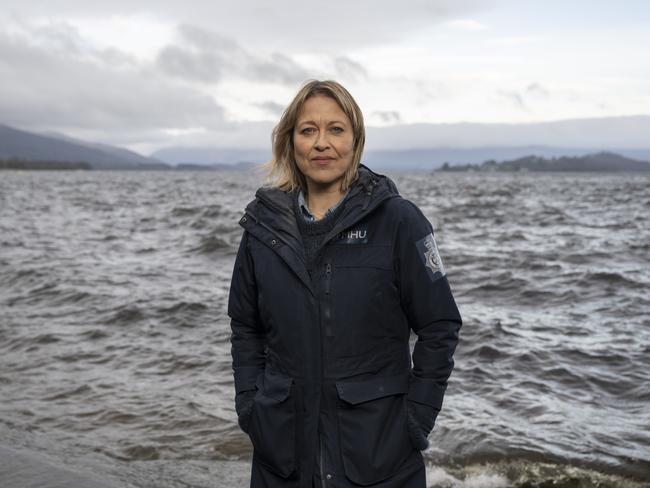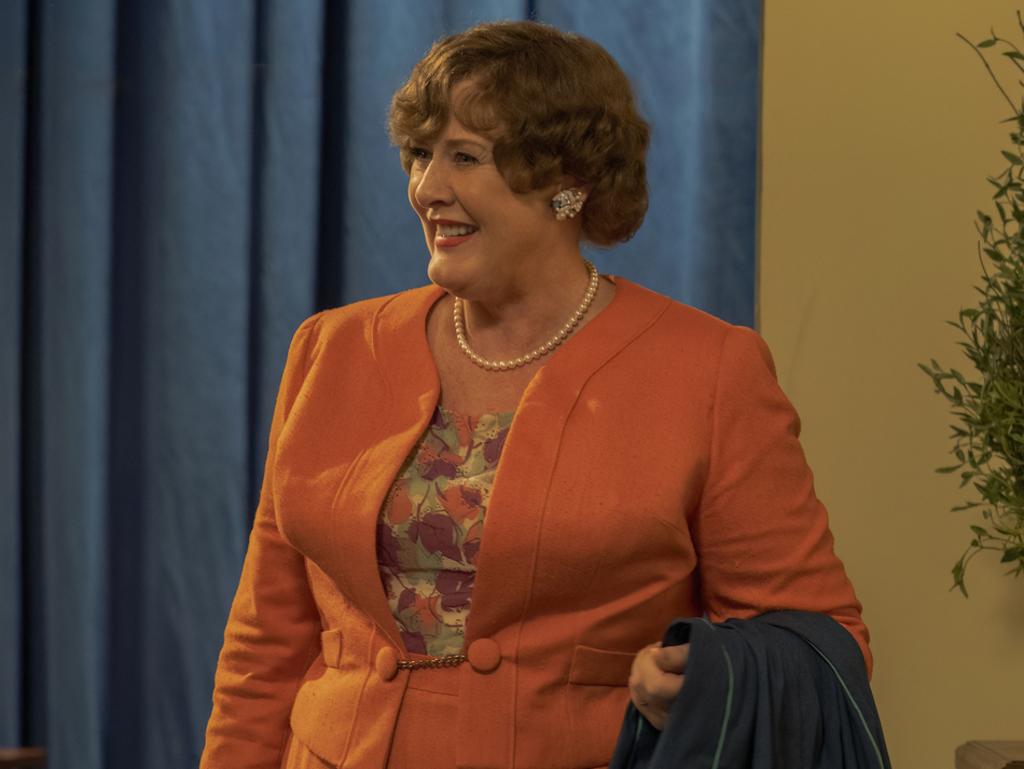Death down the River Clyde
The self-deprecating, speedboat-driving head of Glasgow’s Marine Homicide Unit solves murders while wrangling a teenage daughter in the second season of Annika.

I’ve just caught up with the new season of Annika, the quite delightful comedy drama from the BBC that stars Nicola Walker as DI Annika Strandhed, the droll, self-deprecating, speedboat-driving head of Glasgow’s Marine Homicide Unit. Of Norwegian ancestry, she often references that country’s culture and folklore, sometimes to the bewilderment of her colleagues, as she investigates cases that pile up on the banks of the river Clyde. She does this while attempting, not always successfully, to maintain a relationship with her rebellious teenage daughter Morgan.
The series follows the familiar procedural notion of a murder each week to be solved by her team, which includes Jamie Sives (Guilt) as long-haired, rather bedraggled DS Michael McAndrews, Annika’s former colleague and police diver; Katie Leung (Harry Potter) as DC Blair Ferguson, the forensic brains in the unit; and Ukweli Roach (Grantchester) as DS Tyrone Clarke, the ambitious, newest cop on the team. And they have some grisly matters to investigate in their high-performance RIBs or Rigid Inflatable Boats, hurtling along the Clyde’s tributaries and waterways.
And in the tradition of great procedurals the series follows the lives of the cops involved in the cases, examining their strengths, motives and often complex lives. (The first procedural was arguably created by Lawrence Treat in 1946 with V as in Victim, but it was Evan Hunter, writing as Ed McBain with his 87th Precinct series that took readers inside a station house showing how ordinary cops coped with mayhem on the streets.)
The show was conceived and written by Nick Walker, also a producer and director, and was adapted from his Nordic Noir radio series Annika Stranded for Glasgow’s Black Camel Pictures. He’s also the author of critically acclaimed novels, Blackbox and Helloland. The director is Philip John, best known for his episodes of both Downton Abbey and Outlander and for collaborations with Trainspotting author Irvine Welsh. And he knows just how to keep these stories simple and uncomplicated, much of them shot in close-ups, emphasising the intimacy.
The series takes place in a still changing Glasgow, dominated by the rushing River Clyde: “You get so much for free from this backdrop,” says Walker. “Because the Clyde is the seam that runs through the whole series, it means that every time the unit do their police work, you’ve got the massive metaphor of the show flowing behind it. You don’t realise quite how much work that does.”
On the page of his scripts, he says, you just don’t see it. “But then when it’s all put together, the idea that the plot somehow drifts or washes up on the Clyde, which you see almost all the time, is so helpful. It’s like another 10 pages of script for us.”
And the river runs through a very different place to the great Glasgow city we used to watch in the legendary long-running Scottish cop show called Taggart, then a violent Gothic place. Its creator Glenn Chandler took inspiration for his characters’ names from headstones in a Maryhill cemetery, cementing the show in the city’s history, its characters animated by ghosts.
It’s self-evident these days that every TV mystery has a geography that, depending on the skill of the producers, provides the stage for the action and often plays a critical role in the plot or solution. Think of The Wire’s Baltimore, Bosch’s Los Angeles, the Yorkshire of Happy Valley, Lupin’s joyous Paris, and Breaking Bad’s Albuquerque, New Mexico.
The creators of these shows take us viscerally into a dark and largely hidden subculture of society that few of us, in a nonfictional context, can ever experience. Place exposes character.
In Taggart the so-called second city of the British Empire was still a dark place: its impressive buildings threw long, grimy shadows, legacies of the city’s industrial past; there were young people who could still remember when they thought the natural colour of stone was black.
For more than 100 years, Glasgow’s reason to exist was to serve as the empire’s factory; the industrial revolution was born here with a scream of metal and thundering mills.
But since Taggart’s launch in 1983, Glasgow evolved and changed almost beyond recognition, now the vibrant place we see in Annika, transformed from a place of dark sunrises to one where the stonework is washed, the pavements clean and the streets full of trees.
We see in passing from the skimming boats new glass, concrete and stone palaces, housing media and technology companies, museums and designer penthouses along the river where once shipyards, grain stores and cranes predominated.
The new season begins overlapping with the ending of the first. Annika is thrown from the boot of a car when a hand grenade explodes after she reveals that her former police partner and now subordinate McAndrews is her daughter’s father. The investigation at the centre of the episode is relatively inconsequential and built around the story of a mobile phone having turned up with evidence of murder. The juice is in the way Annika deals with how to tell McAndrews, who is now happily married with daughters of his own. Walker is a delight to watch as she tortuously struggles with this predicament.
Walker is one of the UK’s favourite actors, and ours, too; fans are delirious about her work in series such as Last Tango in Halifax, Spooks and, of course, Unforgotten. That critically acclaimed series, which ran for several seasons, witnessed the rise of the low key but always intense Walker from well-respected character actor to an international prime time TV star. And then her sudden and shocking death when Chris Lang, the show’s creator, did the unthinkable at the conclusion of season four and wrote Walker’s DCI Cassie Stuart out of the series in a confrontingly brutal way.
Her death elicited such shock that even hardened critics said they let out an audible scream. To say nothing of the show’s millions of viewers.
But Walker is back, the show’s appeal all wrapped up in her comic presence, and there’s this lovely trick to the series. Her Annika often rather imaginatively speaks in riddles directly to the audience through what’s known as the fourth wall, that imaginary screen that separates the story from the real word. Somewhat ingenuously, she is offering a glimpse into her cluttered inner life, stepping out of an imagined reality and addressing those of us watching.
This term comes from the theatre, where the three surrounding walls enclose the stage while an invisible “4th wall” is left out for the sake of the viewer. This is the screen we’re watching. We treat this wall like a one-way mirror. The audience can see and comprehend the story, but the story cannot comprehend the existence of the audience.
And Annika does it with such charm she never breaks the suspension of disbelief where we temporarily accept as convincing events or characters that would ordinarily be seen as incredible. (If you’ve ever wondered, it’s a phrase from Samuel Taylor Coleridge who, in 1871, wrote that his works, if supernatural or romantic, should “transfer from our inward nature a human interest and a semblance of truth sufficient to procure for these shadows of imagination that willing suspension of disbelief for the moment, which constitutes poetic faith.”)
It’s used by Walker more effectively in this second season, central to the emotional centre of Annika’s various dramas that affect her family and relationships, as dramatically telling as the more routine procedural elements surrounding the murder of the day.
They are usually structured around various literary works (not just Nordic folk tales), Arcane Scottish ballads, or even George Orwell’s 1984, with reference to Moby Dick. The first episode centres on a traditional Orkney’s folk song called The Great Silkie of Sule Skerry about a Norwegian woman who sleeps with a man who turns into a seal whenever he’s in water.
“It’s probably a metaphor,” Annika mutters in her droll, distracted way. “I hope so because she has a baby with him. It doesn’t work out at all. He’s a seal.”
She’s an anxious delight. But Annika, also a woman of sharp angles, has an empathy with criminals that her male colleagues don’t always share, an understanding of fragile humanity.
It’s a wonderfully gritty, plain-speaking series that doesn’t rely on episode to episode continuity, each self-contained, so you can drop in and out of it at whim.
Annika, streaming on iview.






To join the conversation, please log in. Don't have an account? Register
Join the conversation, you are commenting as Logout